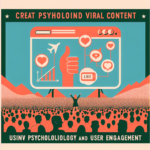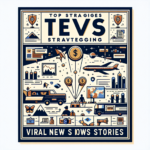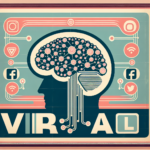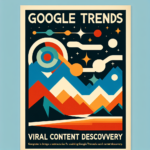Introduction
Hello there! Today, we are going to explore the fascinating world of emotions in content creation. Ever wondered why a particular post, article, or video goes viral, while others get little attention? And how does your content make your audience feel anyway? Well, it’s all about emotions, my friend.
By examining the important role of emotions in viral content, we will uncover insights into why emotions matter, the types of emotions that spark virality, and their significance across different platforms.
Ready to explore emotional triggers and their impact? Interesting fact – did you know a Nielsen Norman Group research reveals that the intensity of emotional response significantly affects the likelihood of action being taken? You’ll discover more of such insight as we progress. Enjoy your read.
The Role of Emotions in Viral Content
Why Emotions Matter
Emotions play an essential role in sharing content. When content evokes a strong emotional response, people are more likely to share it. This sharing behavior is often motivated by the desire to connect with others or express one’s identity.
Research shows that positive emotions like joy and awe often lead to higher shares. However, intense negative emotions like anger or sadness can also drive shares if they deeply resonate with the audience.
Types of Emotions That Spark Virality
Certain emotions are more likely to result in viral content. Below are some impactful emotions:
- Awe: Content that amazes or inspires often gets shared widely. Examples include breathtaking travel videos or breakthrough scientific discoveries.
- Amusement: Humorous content is a staple of virality. Funny memes, bloopers, and clever jokes often attract high engagement.
- Sadness: Emotional stories that tug at the heartstrings can drive people to share as a form of empathy or support.
- Anger: Content that provokes strong disagreement or outrage can lead to discussions and shares as people express their opinions.
- Surprise: Unexpected twists or information can prompt people to share their surprise or shock with others.
Which Platforms Favor Emotional Content
Different platforms favor different types of emotional content. Here’s a brief look at some popular platforms:
| Platform | Favored Emotion |
|---|---|
| Amusement, Awe | |
| Anger, Surprise | |
| Joy, Awe | |
| Inspiration, Surprise |
Best Practices for Creating Emotion-Driven Content
To effectively harness emotions in your content, consider these tips:
- Know Your Audience: Understand what resonates emotionally with your target group. Conduct surveys or leverage analytics tools for insights.
- Create Authentic Stories: Real-life events or genuine stories usually evoke stronger reactions than fabricated ones.
- Use Visuals: Incorporating images or videos can amplify emotional impact and encourage sharing.
- Craft Engaging Headlines: A compelling headline can pique curiosity and set the emotional tone for your content.
The Science Behind Emotional Sharing
According to research by Buffer, emotional arousal is a key driver for shared content. High-arousal emotions, whether positive or negative, lead to more sharing as they trigger a response towards others. This tendency is a way for people to connect and align their emotions with social groups.
Unearthing the Emotional Triggers Theory
Defining the Emotional Triggers Theory
The Emotional Triggers Theory is a psychological concept that states certain stimuli can provoke intense emotional responses, eventually leading to a specific action or behavior. These triggers can be anything that reminds us of past events or experiences – a song, a scent, a piece of content, and more. These triggers connect with our emotional responses, directly impacting our decision-making and action-taking processes.
Embedding Emotional Triggers in Content
To leverage the Emotional Triggers Theory in content creation, marketers seek to:
- Identify emotional triggers: Pinpoint the emotions that most effectively drive the desired action, whether it’s sharing content, making a purchase, or subscribing to a service.
- Link triggers to content: Develop content that evokes these identified emotions, producing the triggers necessary to stimulate the audience’s action.
Understanding Degrees of Emotion
In analyzing the elements that contribute towards virality, it’s essential to understand not just the type of emotion but the degree to which it influences behavior. As revealed in the Nielsen Norman Group’s research, the intensity of an emotional response – whether highly positive or highly negative – significantly affects the likelihood of action.
The Importance of Timing
When it comes to emotional triggers, timing can be everything. Content shared at a time when the audience is likely to be emotionally receptive tends to perform better. For instance, sharing an inspiring story on a Monday morning may trigger more shares as it aligns well with individuals seeking motivation for the week ahead.
Beware of Overusing Emotional Triggers
While effective, harnessing emotional triggers should be done judiciously.
- Avoid Emotional Manipulation: It’s essential to respect your audience and not exploit their emotions solely for business gain. Manipulating emotions can lead to mistrust and damage your brand reputation.
- Maintain Authenticity: Forced or feigned emotions can easily be detected by your audience and can lead to disengagement.
The Significance of Emotional Triggers
Why Are Emotional Triggers Important?
Emotional triggers influence people’s decision-making and behavior on a subconscious level. When content triggers strong emotions, it captures attention and generates engagement, leading to actions like sharing, commenting, or purchasing. These triggers help brands connect with audiences on a deeper level, fostering loyalty and a sense of community around shared feelings.
Emotional Triggers in Advertising
In advertising, emotional triggers are often used to convey brand values and evoke specific emotional responses. For instance:
- Nostalgia: Ads that remind viewers of childhood or past experiences can create a warm, positive association with the brand.
- Fear of Missing Out (FOMO): Limited-time offers or exclusive deals can trigger urgency and prompt immediate action.
- Empathy: Storytelling that highlights real-life challenges and solutions can inspire connection and support.
The Relationship Between Emotion and Brand Loyalty
Emotions don’t just affect immediate reactions; they also play a role in long-term brand loyalty. Emotional bonds with a brand can influence repeat purchases and word-of-mouth recommendations. As emotional connections strengthen, customers are more likely to advocate for the brand, thus driving organic growth.
Challenges in Measuring Emotional Impact
Quantifying emotional impact can be challenging for marketers. While analytics tools can track engagement metrics, understanding the nuanced emotional responses of audiences often requires qualitative methods like surveys and focus groups. These insights help fine-tune strategies to better align with emotional triggers, although there might still be gaps in fully capturing emotional nuance.
Case Studies of Successful Emotional Marketing
Brands that successfully use emotional marketing often stand out. A prime example is Nike’s “Just Do It” campaign, which taps into emotions of empowerment and athletic achievement. Similarly, Dove’s “Real Beauty” campaign highlights themes of self-esteem and authenticity, resonating deeply with its audience and encouraging positive brand engagement.
Understanding Emotions in Content Interaction
The Influence of Emotional Engagement
The way individuals interact with content is significantly influenced by their emotional engagement. Emotions determine the level and type of interaction, impacting not only whether someone will share content but also how they perceive and discuss it. This emotional interaction goes beyond simply liking or disliking content; it can solidify personal identity and group belonging.
For instance, when content aligns with personal values or experiences, it’s more likely to be perceived positively and shared among peers who hold similar views, forging a deeper sense of community. Humans have an intrinsic need to belong and connect, and sharing emotionally resonant content is one of the ways they fulfill that need.
Cross-Cultural Emotional Differences
Cultural context plays an essential role in how emotional triggers are perceived and acted upon. Different cultures may respond differently to the same emotional stimuli due to varied cultural norms, values, and communication styles. It’s essential for marketers and content creators to recognize these differences when targeting diverse audiences.
For example, content that appeals to themes of independence might resonate strongly in Western cultures, where individualism is highly valued. However, in collectivist cultures, content that emphasizes community and family may evoke a stronger emotional response.
The Role of Emotion in Decision-Making
Emotions heavily influence decision-making processes. While logic and facts can guide thoughts, emotions often drive decision outcomes. This concept is critical in marketing and advertising, where emotional appeal can be as compelling—if not more so—than factual content.
People frequently justify their emotionally-driven decisions with logical reasoning afterward, a phenomenon known as post-rationalization. This insight is valuable for content creators who aim to craft messages that are both emotionally engaging and factually persuasive.
Emotional Content in Crisis Communication
Emotions are especially critical during crisis communication. In times of uncertainty or distress, people seek content that provides not only information but also emotional support. Empathetic and reassuring communication can strengthen the relationship between the audience and the brand or entity, fostering trust and alleviating anxiety.
For instance, during natural disasters or health crises, content that communicates empathy and solidarity can vastly improve public perception and engagement with an organization. The key is balancing factual information with emotional support to effectively address the audience’s needs.
Impact of Emotions on Content Recollection
Emotional content significantly impacts memory retention; people tend to remember emotionally charged content more vividly than neutral content. A strong emotional response can enhance memory consolidation, making it easier for the audience to recall the content later. This effect is beneficial for marketers aiming for long-lasting brand recall and engagement.
Understanding these facets of emotional engagement can greatly enhance content strategies, allowing creators to connect more deeply and authentically with their audience. For further exploration, you can read how emotional content becomes a key to virality through an article by Buffer.
Wrapping It Up: Emotional Triggers Behind Viral Content
Viral content’s magic lies in its power to stir emotions, incite reactions, and encourage sharing among audiences. Indeed, emotions are instrumental in how people connect with content, driving behavior ranging from simple content shares to brand loyalty. Equally important are the emotional triggers that provoke these responses. From awe-inspiring visuals to humorous anecdotes, these elements serve as catalysts for emotional involvement and, subsequently, audience interaction.
Moreover, brands must acknowledge the nuanced nature of emotions. Each emotion can elicit different reactions across various platforms and among different cultures. Thus, understanding your audience’s emotional landscape can significantly boost your content’s chances of going viral. Lastly, while emotions are a potent tool in content marketing, they must be wielded responsibly and authentically to maintain trust and foster sustained audience engagement.
Frequently Asked Questions – FAQs
Why are emotions important in content marketing?
Emotions play a vital role in how audiences engage with content. Emotional responses, whether positive or negative, drive people’s behavior, provoking them to share content, comment, or even make a purchase. These emotional reactions form a deep connection between the audience and the content or brand, driving engagement to new heights.
What emotions spark virality?
A wide range of emotions can spark virality, from positive ones like awe and amusement to negative ones like anger or shock. It’s essential to note that different emotions may resonate differently with different audiences or on different platforms. Understanding what emotions drive your audience can help tailor your content for maximum engagement.
How can I effectively use emotional triggers in my content?
Successfully using emotional triggers starts with understanding your audience and their emotional responses. You can then create authentic stories that resonate with these emotions and use visuals and engaging headlines to amplify the emotional impact.
What is the Emotional Triggers Theory, and why is it relevant?
The Emotional Triggers Theory is a psychological concept that suggests stimuli can provoke intense emotional responses, leading to specific actions or behaviors. These triggers are often used in content marketing to drive certain actions, like sharing, making a purchase, or subscribing to a service.
How can emotional engagement influence content interaction?
Emotional engagement greatly influences how audiences interact with content. It can solidify personal identity, create a sense of belonging, and build a deeper sense of community. By understanding and leveraging these emotional connections, brands can foster loyal communities around their content or products.






